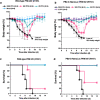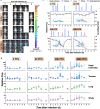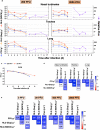Real-time tracking of bioluminescent influenza A virus infection in mice
- PMID: 35210462
- PMCID: PMC8873407
- DOI: 10.1038/s41598-022-06667-w
Real-time tracking of bioluminescent influenza A virus infection in mice
Abstract
Despite the availability of vaccines and antiviral therapies, seasonal influenza infections cause 400,000 human deaths on average per year. Low vaccine coverage and the occurrence of drug-resistant viral strains highlight the need for new and improved countermeasures. While influenza A virus (IAV) engineered to express a reporter gene may serve as a valuable tool for real-time tracking of viral infection, reporter gene insertion into IAV typically attenuates viral pathogenicity, hindering its application to research. Here, we demonstrate that lethal or even sublethal doses of bioluminescent IAV carrying the NanoLuc gene in the C-terminus of PB2 can be tracked in real-time in live mice without compromising pathogenicity. Real-time tracking of this bioluminescent IAV enables spatiotemporal viral replication tracking in animals that will facilitate the development of countermeasures by enhancing the interpretation of clinical signs and prognosis while also allowing less animal usage.
© 2022. The Author(s).
Conflict of interest statement
The authors declare no competing interests.
Figures









Similar articles
-
A Novel Fluorescent and Bioluminescent Bireporter Influenza A Virus To Evaluate Viral Infections.J Virol. 2019 May 1;93(10):e00032-19. doi: 10.1128/JVI.00032-19. Print 2019 May 15. J Virol. 2019. PMID: 30867298 Free PMC article.
-
Fluorofurimazine, a novel NanoLuc substrate, enhances real-time tracking of influenza A virus infection without altering pathogenicity in mice.Microbiol Spectr. 2025 Mar 4;13(3):e0268924. doi: 10.1128/spectrum.02689-24. Epub 2025 Jan 27. Microbiol Spectr. 2025. PMID: 39868868 Free PMC article.
-
Replication-Competent ΔNS1 Influenza A Viruses Expressing Reporter Genes.Viruses. 2021 Apr 17;13(4):698. doi: 10.3390/v13040698. Viruses. 2021. PMID: 33920517 Free PMC article.
-
Infection of Mouse Macrophages by Seasonal Influenza Viruses Can Be Restricted at the Level of Virus Entry and at a Late Stage in the Virus Life Cycle.J Virol. 2015 Dec;89(24):12319-29. doi: 10.1128/JVI.01455-15. Epub 2015 Sep 30. J Virol. 2015. PMID: 26423941 Free PMC article.
-
Replication-Competent Influenza A Viruses Expressing Reporter Genes.Viruses. 2016 Jun 23;8(7):179. doi: 10.3390/v8070179. Viruses. 2016. PMID: 27347991 Free PMC article. Review.
Cited by
-
Single-cycle, pseudotyped reporter influenza virus to facilitate evaluation of treatment strategies for avian influenza, Ebola and other highly infectious diseases in vivo.Front Immunol. 2025 Jul 10;16:1608074. doi: 10.3389/fimmu.2025.1608074. eCollection 2025. Front Immunol. 2025. PMID: 40709188 Free PMC article.
-
Fluorescent and Bioluminescent Reporter Mouse-Adapted Ebola Viruses Maintain Pathogenicity and Can Be Visualized in Vivo.J Infect Dis. 2023 Nov 15;228(Suppl 7):S536-S547. doi: 10.1093/infdis/jiad136. J Infect Dis. 2023. PMID: 37145895 Free PMC article.
-
Spatial kinetics and immune control of murine cytomegalovirus infection in the salivary glands.PLoS Comput Biol. 2024 Aug 16;20(8):e1011940. doi: 10.1371/journal.pcbi.1011940. eCollection 2024 Aug. PLoS Comput Biol. 2024. PMID: 39150988 Free PMC article.
-
Triphasic production of IFNγ by innate and adaptive lymphocytes following influenza A virus infection.Discov Immunol. 2023 Aug 19;2(1):kyad014. doi: 10.1093/discim/kyad014. eCollection 2023. Discov Immunol. 2023. PMID: 37842651 Free PMC article.
-
Segmented, Negative-Sense RNA Viruses of Humans: Genetic Systems and Experimental Uses of Reporter Strains.Annu Rev Virol. 2023 Sep 29;10(1):261-282. doi: 10.1146/annurev-virology-111821-120445. Annu Rev Virol. 2023. PMID: 37774125 Free PMC article. Review.
References
-
- Centers for Disease Control and Prevention, National Center for Immunization and Respiratory Diseases. CDC Seasonal Flu Vaccine Effectiveness Studies. Centers for Disease Control and Prevention. https://www.cdc.gov/flu/vaccines-work/effectiveness-studies.htm (Accessed 5 August 2021).
Publication types
MeSH terms
LinkOut - more resources
Full Text Sources
Research Materials

